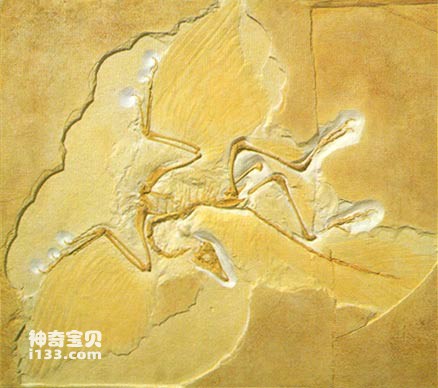In 1861, the oldest bird fossil was discovered in the Upper Jurassic limestone (a limestone formation formed in the late Jurassic) in Solnhofen, Bavaria, Germany. Not only were the bones preserved, but there were also traces of feathers. , it was named Archaeopteryx. Since then, a total of seven Archaeopteryx fossils have been unearthed in Solnhofen.

Archaeopteryx
Archaeopteryx is as big as a crow. It retains many characteristics of reptiles: for example, it has teeth in its mouth instead of forming a horny beak like modern birds; it has a long tail composed of 21 tail vertebrae; the three metacarpal bones of the forelimbs are separated from each other and do not heal into the carpometacarpal bones. There are claws at the tips of the fingers; there are no air pockets inside the bones; etc. But on the other hand, it already has feathers, and it already has primary flight feathers, secondary flight feathers, tail feathers and compound feathers differentiated, which are all characteristics of birds. In addition, it also shows some other bird characteristics or transitional characteristics in some bone morphology. For example, its third metacarpal bone has healed with the carpal bone, but the second and first metacarpal bones have not yet healed. Therefore, some scientists believe that this reflects the In birds, the metacarpal bones are the beginning of healing into the carpometacarpal bones. It is precisely because the characteristics of birds have evolved and developed based on the characteristics of reptiles that some people jokingly call birds "glorified reptiles."
Precisely because the skeletal structure of Archeopteryx is very similar to that of a small carnivorous theropod dinosaur called Coelurosaurus, some people have long thought that birds originated from Coelurosaurs, and speculated that the high metabolic level of birds comes from Inherited from those dinosaurs, that is to say, some small carnivorous dinosaurs may have been warm-blooded animals. Some people speculate that the beginning of the development of feathers is not necessarily related to flight, and it may have been common among primitive theropod dinosaurs.
From the series of characteristics that Archaeopteryx has retained that are similar to those of reptiles, it can be seen that its structure to adapt to all aspects of flight is still very imperfect, so it is speculated that it can only glide at low altitudes. So, how did Archeopteryx change from walking on land to gliding in the sky? Scientists are of two minds on this.
One opinion is that it turned out to be an animal that was good at running. Starting from running, the forelimbs are used to beat the air to increase speed during running. At this time, the mutated type of primitive feathers on the forelimbs, which were transformed from scales, gradually improved in the process of adapting to this habit, and finally developed feathered wings. By flapping its wings, it begins to leave the ground and glide into the air. This theory is called the "running theory" of the origin of bird flight.
Another opinion is that Archaeopteryx was originally arboreal, and gliding on trees with feathered wings was an advantageous way of activity. This allowed the mutated type of primitive feathers on the forelimbs to survive from scales. and the opportunity to reproduce, eventually developing feathered wings and gaining the ability to fly. This theory is called the "arboreal theory" of the origin of bird flight.
Later, according to the fifth Archaeopteryx specimen, it not only had claws on its wings, but also had sharp and curved claws at the end of its hind toes. This kind of claw is not good for running, but good for climbing branches. This seems to support the arboreal theory.
animal tags: Archaeopteryx
We created this article in conjunction with AI technology, then made sure it was fact-checked and edited by a Animals Top editor.